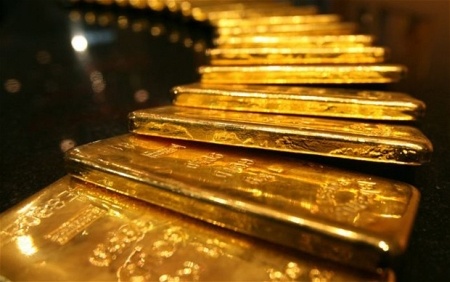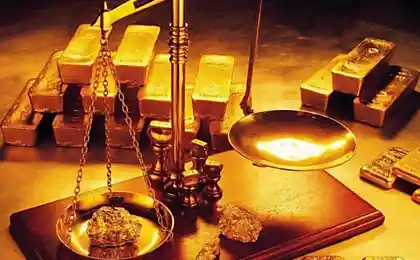1721
50 facts about gold

1. Translated from the Proto-Indo-European roots of the term "gold" means "yellow", "green" or perhaps "bright".
2. Gold - a rare metal. Every hour of the world's steel is cast more than it produced gold in the history of mankind.
3. On Earth, there are deposits of gold on all continents.
4. The melting point of gold is 1064, 43 degrees Celsius. This metal is excellent conductor of heat and electricity, never rust.
5. Gold - one of the most precious metals. The high cost of gold has become a tool for the development of active mines in different parts of the world. Nevertheless, it is believed that 80% of the total reserves of precious metal are still within the Earth.
6. 75 percent of the total weight of gold, located today in circulation, was produced after 1910.
7. Medical studies of the early twentieth century have shown that gold is an effective tool in the treatment of rheumatoid arthritis.
8. Gold - a very flexible metal. From it you can make sewing thread. One ounce of gold (28, 35 grams) can be stretched up to 80 kilometers.
9. Although gold - metal, it is edible. In some Asian countries, it is added to the fruit, jelly desserts, coffee and tea. Since the 1500s gold leaf began to put in bottles with strong alcoholic beverages (eg, Goldschlager, Danziger Goldwasser). Some Indian tribes believed that the use of gold in the food gives the ability to levitate.
10. The weight of one of the largest gold nuggets stood at 72 kg, its dimensions are - 31 × 63, 5 cm. Was found "treasure" was John Deason and Richard in Australia, February 5, 1869. Nugget was named "Hello, stranger." It is noteworthy that the gold "stone" was located at a depth of five centimeters from the ground.
11. During the economic crisis in March 2008, the price of gold is rapidly "soared" up and exceeded $ 1,000 per ounce (28, 35 grams). It was the only such case in the history.
12. In times of recession, investors tend to transfer their assets into gold and silver. Thus, according to the report World Gold Council, in the second half of 2008, demand for investing in precious metals rose sharply.
13. Dow / Gold ratio showing how much gold is required to purchase one share of Dow, is a great "renderer" of the global economy. So, in early 2009, the index Dow / Gold fell to the same indicators that have been recorded in the 1930 and 1980 years.
14. Gold - chemically inert substance, so it never rusts and will not cause skin irritation. If a piece of jewelry made of gold caused an allergic reaction, then added another in the alloy metal.
15. One cubic foot of gold (about 27 cm3) weighs half a ton. The largest gold bar weighs 200 kg (440 pounds).
16. In 2005, Rick Munarriz asked what is more favorable for investment: buying gold shares or Google. It turned out that both "product" equivalent in the stock market. By the end of 2008, Google finished at $ 307, 65, while gold "skyrocketed" in the price to $ 866 per ounce.
17. Medals for Olympic champions were cast entirely of gold. In today's gold medals covered only "outer shell". This takes 6 grams of the precious metal.
18. The Incas called gold "Tears of the Sun". It was believed that this metal - a gift from the people of the Sun God. Then the gold ornaments were purely aesthetic and religious significance, the financial strength they had.
19. Around 1200 BC the ancient Egyptians sieved gold dust from the sand of the sea with the help of untrimmed sheepskin. It is a craft is likely to become a source of legends about the "Golden Fleece».
20. In ancient Egypt, gold was considered a skin / flesh of the gods. In particular, the Sun God Ra. For this reason, the precious metal was available only pharaohs, their family members and clergy. Chamber, which houses the sarcophagus of the king, called the "house of gold».
21. In ancient times, the largest producer of gold was considered Nubia, as evidenced by data from the Turin papyrus. At that time, the slaves were transferred terrible suffering, extracting gold nuggets and gold dust sifting dirt from the usual Egyptian jewelers, jewelry is made for the nobility enjoyed in society is very high, almost sacred position.
22. Although the ancient Jews had enough gold to build a golden calf, likely story about dancing around him, while Moses spoke with God on Mount Sinai, is a fiction. Scientists argue that gold in those days had nothing to do with money, and the Jews in the head could not come to bribe the gods of the golden calf.
23. Gold Bible mentioned at least 400 times. In particular, there are instructions from God to cover the furniture in the tabernacle "pure gold." Also, this metal is mentioned as one of the gifts of the Magi.
24. The Greeks believed that the gold - a dense combination of water and sunlight.
25. In 560 BC Lydians released the world's first gold coin. However, it was not made of pure gold, and of electrum - an alloy of gold and silver. Herodotus criticized the materialism of the Lydians, who were also the first who opened retail stores. Around the world, the use of gold coins began after land Lydians captured Persians.
26. Before the gold coins came into use, calculated for goods plant products, various types of livestock (usually cattle). Construction work in antiquity were made slaves, and they pay the money was not necessary.
27. The element «AU» Latin Aurum means "shining light».
28. When the goose cry warned the Romans of the Gauls intention to attack the temple, which contained all their treasures, the people of Rome as a sign of gratitude to the goddess Warnings (Moneta) built a sanctuary. Communication between the saved savings and Moneta adopted in the English language, related words «money» and «mint».
29. From 307 through 324 years. BC the cost of one pound of gold in Rome grew from 100,000 dinars (Roman coin) to 300,000 dinars. By the middle of the fourth century, a pound of gold was worth 2.12 billion dinars. That's a clear example of rampant inflation, which is partly to blame for the decay of the Roman Empire.
30. Proof coins in England (public inspection quality gold) began in England in 1282 and continues to this day. The term «pyx» descended from boxwood chest in which coins are stored, the quality of which will check. Today coins are checked for compliance with the diameter, as well as the normative weight and chemical composition.
31. In the fourteenth century molten gold with crushed emeralds used in the treatment of bubonic plague.
32. In 1511 the Spanish King Ferdinand expressed his legendary phrase: "Get gold humanely if possible - if not win, no matter what the danger».
33. Both the Greeks and the Jews began to practice alchemy 300's BC Looking for a way of transmuting base metals into gold reached its peak in the late Middle Ages and the Renaissance.
34. In 1599 the Spanish governor Jivaro tribe overlaid so much tax that he was executed, a bay in the throat molten gold. This type of punishment is widely practiced by the Romans and the Spanish Inquisition.
35. Golden Ducat, coined in Venice in 1284, for 500 years remained the most popular coin in the world. Dukat in Latin means "prince". The coin used in the time of Shakespeare Romeo and Juliet, as well as mention of it there in the play "The Merchant of Venice» («The Merchant of Venice»). About Golden Ducat in one of his songs («I Is not the One») sings the rapper Ice Cube on them as mentioned in the sci-fi movie "Babylon 5" as a monetary race Centauri.
36. Initially, the US Mint issued coins of pure gold par value of $ 2.50, $ 10 and $ 15. ceased minting of precious coins in 1933, with the advent of the Great Depression.
37. American football team «49ers» was named for the prospectors who arrived in 1849, during the "gold rush" in Northern California.
38. Gold and copper - the first metals found in human beings (the first finding supposedly occurred 5000 years BC).
39. The value of gold is decisive for the majority of the world's many currencies. After World War II, the United States launched the Bretton Woods system, under which the cost of one US dollar was 1, 35 troy ounces of gold (1 ounce = 888, 671 mg). The system was officially closed in 1971, when the gold reserves was not enough to cover the cost of paper money in circulation.
40. The largest gold reserves located in the vault of the Federal Reserve Bank of New York - there are more than 500 000 gold ingots (25% of world reserves). The bank is more gold than Fort Knox (Fort Knox), most of the treasures owned by foreign governments.
41. The term "troy ounce" of gold came from the name of the French city of Troyes, which was the world's first system of weights for precious metals and stones. One troy ounce is equal to the weight of 480 grains (one grain weighs exactly 64, 79 892 mg).
42. The gold standard was abolished, and in its place came standard currency adopted by most governments - fiat, or fiat money. US Presidents Thomas Jefferson and Andrew Jackson strongly opposed this decree, as agreed with the majority of economists who are convinced that fiat increases the cyclical ups and downs of inflation.
43. The depth of the mines of the South African mines, which are mined gold, up to 3, 6 km away, and the air temperature - 54 degrees Celsius. To produce one ounce requires 38 man-hours, 140 liters of water, the presence of chemicals (acids, cyanide, lead, borax, lime) in an amount of electricity is sufficient to supply a residential house for 10 days. To heal from the depths of Africa, the annual volume of gold mined on the continent (about 500 tons) is required to raise the earth's surface and passaged more than 700 million tons of soil.
44. Throughout the history of gold mining land was seized about 142 000 tons of gold. If we take the price of gold equal to $ 1,000 per ounce, the total cost of the metal will be about 4, 5 trillion dollars. In the United States alone, in circulation and deposits is about 7, 6 trillion dollars, so a return to the gold standard is not possible. Although most experts believe that a return to the use of gold coins is unrealistic, there are libertarians and Objectivists believe that the enactment of the gold standard could ease inflation risks and limit the influence of the government.
45. The first officially registered gold nugget was mined in the United States, in Cabarrus, North Carolina. His weight was 17 pounds (7, 7 kg). It was North Carolina became the birthplace of "gold rush". After the second nugget found here in 1803.
46. In 1848, during the construction of a sawmill for Jojo Sutter near Sacramento John Marshall discovered gold in the ground flakes. This discovery caused a "gold rush" in the American West, and resulted in his active move.
47. In 1933, Franklin Roosevelt signed Executive Order 6102, which prohibits the accumulation of gold by US citizens. Disobeyed were punished by a fine of $ 10 000 or 10 th years in prison. The scope of the decree did not get jewelers, dentists, electricians and other "industrial" workers.
48. Tiny grains of gold used Amersham Corporation of Illinois to determine the functions of specific proteins and treatment of various diseases.
49. The purity of gold is determined in carats. The term "carat" is derived from the seeds of the carob tree, which are used in the Middle East for weighing. Carats - bean fruits, each pod carob weighs 5.1 grams (200 mg).
50. Gold weight in carats can be 10, 12, 14, 18, 22 or 24. The higher the score, the higher the quality of gold. "Pure Gold" is considered a minimum weight of 10 carats. "Pure gold" - 24 carats, however, and it contains a small amount of copper. Pure gold is soft and ductile so that it can be molded manually.
























